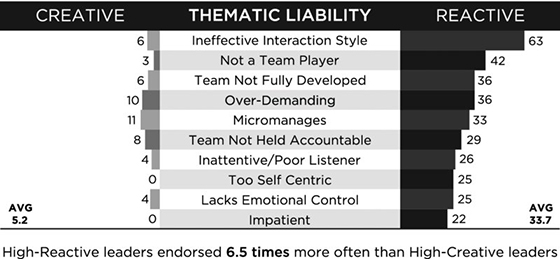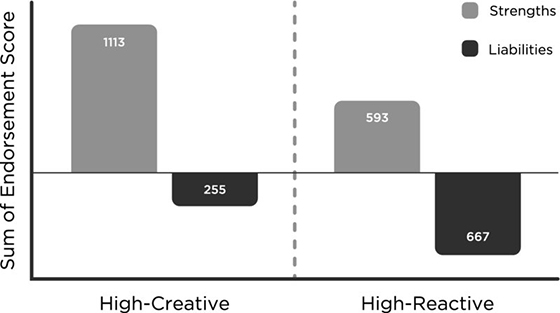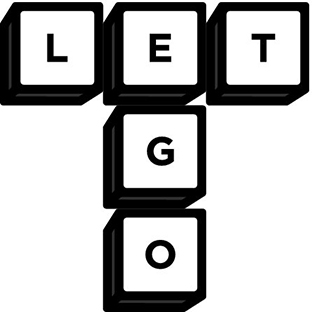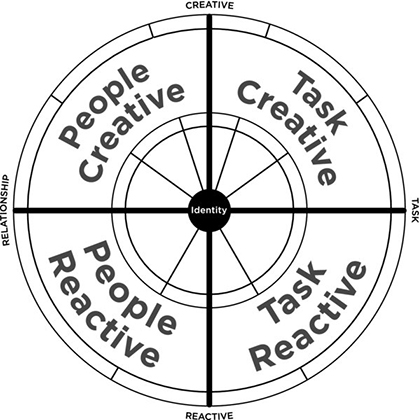Chapter 6
Leader Liabilities
Most Reactive versus Most Creative
None of us is a perfect human being; we all have limits and liabilities. Leaders live out loud and their strengths, weaknesses, and liabilities are on display all day, every day. This is just the way it is. In spiritual boot camp, weaknesses and liabilities go with the territory. There’s no shame in that. They become invitations to transformation. We all have the ability to evolve and turn our weaknesses and liabilities into strengths and assets. And since each of us possesses that ability, it’s in our best interest to take advantage of it.
How We Interrupt Our Effectiveness
In our study, the leaders who provided feedback have much to teach about what interrupts effective leadership and how we can get in our own way. Here’s an example:
John is an individual who, in his professional life, does not suffer fools gladly, who takes challenges to his authority personally, who does not allow real or perceived slights to his status to go without a vigorous and sharp reaction, and who demands public recognition for his ideas, work, and contribution to (shared or individual) successful outcomes.
John can go on the attack! When acting from the perception he has formed on an issue, his assault can be consuming. It becomes difficult, if not impossible, in the moment for him to see any other reality. His situational inquiry, ostensibly delivered as questions to inform, is actually designed to elicit responses that build a case for the conclusion he has already reached. Have that process go awry, and his ire only grows. So, it is easier to allow John to have it his way—the way he sees it.
John’s greatest leadership challenge is learning to shift the focus away from himself and onto others. The situation always comes back to him. He is arrogantly confident in his opinions/conclusions. He does not listen. He is closed to and shuts down others’ good ideas. He needs to learn that others have much to contribute. He needs to let go, learn to allow others’ ideas to positively influence his thinking, and develop the brilliance of his team. He will never realize his significant leadership potential unless he can look through the lenses of others’ experiences, see the world from their various perspectives, and use his power to lead for collective success.
This comment is only one of thousands of similar comments that point to the liabilities of Reactive leaders.
Top 10 Liabilities of High-Reactive Leaders
Here are the top 10 High-Reactive leader liabilities in order from most frequently endorsed to least. The definitions are created from language used in the written comments gathered in our database from leaders all around the globe.
What strikes you about this list? What do you notice?
- Ineffective Interaction Style: Off-putting verbal and nonverbal communication style, often described as arrogant, condescending, dictatorial, confrontational, or overly critical.
- Not a Team Player: Operates independently and does not provide enough support for the team, or recognize its needs. Makes decisions in isolation and focuses on only his or her own goals.
- Team Not Fully Developed: Does not provide development opportunities. Does not clearly define roles and responsibilities.
- Over-Demanding: Drives others too hard, too fast, and sets unrealistic expectations such that others cannot keep up with their current capability. Is unforgiving and harsh when expectations are not met.
- Micromanages: Does not trust others to get the job done or empower people to make decisions and resolve issues. Tries to do it all by himself/herself.
- Team Not Held Accountable: Teams are not held accountable for quality results and struggle to execute against strategy to meet deadlines. Lacks quality focus by settling for “good enough.”
- Inattentive/Poor Listener: Does not listen to others’ ideas, especially those ideas that do not match their own. Engages in other tasks while people are speaking or will interrupt them to present his or her own ideas.
- Too Self-Centric: Puts personal agenda and gain ahead of the team. Boasts and takes credit for other’s work.
- Lacks Emotional Control: Has a temper and launches into emotional outbursts and tirades, particularly when things do not go as planned.
- Impatient: Becomes easily frustrated when others are too slow to catch on. Tends to rush through things rather than giving them time for understanding and informed decision making.
Figure 6.1 shows the endorsement scores for the top 10 liabilities of High-Reactive leaders. Their scores are on the right side of the figure, and the corresponding scores for High-Creative leaders are on the left. The differences are clear and stark: High-Creative leaders barely move the needle when it comes to the liabilities that High-Reactive leaders have, while High-Reactive Leaders have plenty to choose from. The only liabilities mentioned for High-Creative leaders are related to overwork. Otherwise, there was little mention of liabilities for High-Creative leaders.

Figure 6.1 Top 10 Liabilities of High-Reactive Leaders
A quick comparison of the numbers tells the story:
- Ineffective interaction style, 63 to 6.
- Not a team player, 42 to 3.
- Team not fully developed, 36 to 6.
- Over-demanding, 36 to 10.
- Micromanages, 33 to 11, and so on.
If you average both columns, the average score for High-Creative leaders is 5.2 compared to an average score of 33.7 for High-Reactive leaders—a 6.5 times difference!
Recall that the top 10 strengths of High-Creative leaders are 2.3 times more endorsed than High-Reactive leaders and that High- Creative leaders are six times more frequently endorsed on the Differentiating Strengths list. And here we see that with High-Reactive leaders, the liabilities are 6.5 times more prevalent!
We notice that the top 10 High-Creative strength list is loaded with people strengths. Conversely, the top 10 High-Reactive liability list has to do with lousy human interactions. This list is the opposite of deep relationship and radical humanity. It is also highly unlikely to inspire purposeful achievement.
If you want a list of how to disrespect, discourage, and disempower people, this is a good one. In the way that antimatter annihilates matter, these anti-relationship behaviors cancel out a leader’s relationships and therefore his or her effectiveness. Further, these Reactive behaviors disrupt and damage the conditions for scale, stunting the organization’s growth.
High-Reactive leaders comprise 28 percent of our database. From our experience, this is also true of most Extended Leadership Teams. If your Extended Leadership Team is comprised of 28 percent High-Reactive leadership, think about the cost of this—and the missed ROI—because ineffective leadership offsets effective leadership.
Case Example: President Edwardo
Edwardo is the president of an organization. As you read the comment below, see if you can identify the towering strengths that helped him get promoted into his current position but have become Non-Differentiating. Also, see if you can spot the liabilities that Edwardo possesses as a leader.
Edwardo is extremely intelligent and typically gets to the solution before everyone else. This is often his downfall as he moves quickly to implementing a solution when in fact the organization is two steps behind him. This creates a disconnect with the team. In his role as president, he should be “teaching people how to fish.” Unfortunately, Edwardo gets frustrated with the lack of responsiveness from the organization and, as a result, hands over the “fish.” This can create insecurity and frustration, with people feeling they cannot live up to his expectations.
Edwardo does not leverage his team to create the desired vision. Because he is intelligent and gets to answers faster than most, he loses patience and decides to do all the work himself. By doing so, he misses out on the input of others and fails to garner support for the vision. When he becomes quickly entrenched in his position, he often ignores valid input and alternative points of view.
Edwardo thinks he knows best (he does not listen to others), and he does not inspire confidence in his team. As a result, his “professional arrogance” creates more of a dictatorial leadership style, which in turn produces adversarial relationships internally (Edwardo versus everyone). Over time, this outcome will also spread to external partners. In the end, we will continue to lose talent, which will eventually impact business performance.
Like many leaders we meet and work with worldwide, Edwardo is a classic example of a brilliant man reaching the limits of his development. He is facing his development gap. We suspect his leadership effectiveness has capped out or is steadily decreasing as a result.
While this comment does not provide us with Edwardo’s business context, we can assume he is in over his head, under stress, and defaulting to reactivity, which undermines his effectiveness. The combination of Non-Differentiating Strengths (however towering) and the Reactive default behaviors that show up under pressure puts Edwardo at his limits to scale. Too much depends on him, and his working more, harder, and faster will make things worse.
Edwardo is not merely challenged to develop additional competencies, he has reached the limits of Reactive leadership and is challenged to evolve into a Creative leader, the first condition for scaling leadership.
Leadership Ratio
What is the balance of strengths to liabilities of these two groups of leaders? What is each group’s Leadership Ratio?
Figure 6.2 illustrates the sum of all strengths and liabilities for both groups. These total scores are not based on the top 10 lists. Instead, we totaled the endorsement scores for all 40 strengths and all 37 liabilities identified in our study. High-Creative leaders had a total endorsement score for strengths of 1,113 versus 255 for liabilities. This gives High-Creative leaders a strengths-to-liabilities ratio of 4.4 to 1. Not surprisingly, High-Reactive leaders are endorsed more often for their liabilities at 667 compared to 593 for their strengths, which gives them a ratio of 0.9 to 1.

Figure 6.2 Sum of All Strengths and Liabilities
Think about that. If you have a Leadership Ratio of 0.9 to 1, it means you are in your own way. It also means the harder you go and the longer you work, the more you get in your own way and the less you accomplish. You may try to counter this by working even harder, but eventually you’ll hit a wall, both personally and with your people. This does not mean you are not proficient at getting results. It means that, from a leadership perspective, you are not developing the capability and capacity (scaling leadership) of people and teams to create what matters.
Your Leadership Ratio gives you an indication of the effect you are having on people and your organization. As the complexity of your organization and environment increases, your multiple—the return on your leadership—must increase. For example, if you routinely give an hour and only get an hour in return, you are investing your time ineffectively. You won’t be an effective leader of leaders. You can and must do better, much better.
How do you increase the multiple on your leadership? By increasing your Leadership Ratio. Extremely effective leaders get a 10, 20, even 1,000 to 1 return on their time and interactions, and they do this by maintaining a high Leadership Ratio. If your Leadership Ratio does not grow with the organization, you become the limit to scale. The same is true for your team of leaders. If your team’s Leadership Ratio does not grow, then the organization’s leadership does not scale at the level required.
Furthermore, if you are a High-Reactive leader, you likely lead with Non-Differentiating Strengths. This means you lead primarily with strengths that get results through your own drive and capability, not through developing capability and capacity in others. Hence, a Leadership Ratio of 0.9 to 1 is not going to scale. This is a serious liability. You are dragging down and even cancelling out your own effectiveness and that of your leadership team. Not only are you not putting in place the conditions for scaling leadership, you are actively preventing those conditions from emerging.
Erik Fyrwald, CEO of Syngenta, recalled when he learned he couldn’t do it all by himself. He said: “Fifteen years ago, I realized I would not get any more operating P&L experience until I learned to let go, trust other people, and not need to be the smartest guy in the room—to always be right.”
Erik’s three-fold developmental agenda—to let go, trust other people, and not have to be the smartest guy in the room—created a greater capacity to meet complexity in himself while increasing his Leadership Ratio. This allowed him to increase the multiple on his leadership by behaving in a way that consistently created greater capacity in others and within his team.
Erik’s deep learning is being absorbed by those around him. Today, we work with Erik and his Senior Executive Team, and with Jon Parr, the president who has responsibility for a large piece of Syngenta’s business. After Jon had received feedback regarding his leadership, he pulled out a notebook, wrote down two words (Figure 6.3), and said, “This is the way I have to look at my leadership.”

Figure 6.3 Let Ego Go
He continued: “I have to make decisions and lead in a way that’s not driven by ego but in a way that builds the capacity and capability of my team to lead.” Jon is recognizing that driving and pushing himself and others harder, versus developing the leaders that work with him, reduces his Leadership Ratio. He has become focused on involving his entire team to develop its capability to lead the more than 20,000 people in Syngenta’s Crop Protection Business. Jon is letting go, developing others, holding them accountable and, in the process, becoming more radically human. As a result, he is setting up the conditions for scale.
All things change when we do. As Erik does his leadership work, so does his entire team and the Extended Leadership Team—now a priority for Erik and for Syngenta. This is how scaling leadership works.
What Is Your Return on Leadership?
Are your strengths a multiple of your liabilities, or are you getting in your own way? What is the return on your leadership? Does your Leadership Ratio give you a high return on your leadership or not? Are you increasing the multiple on your leadership by developing other leaders around you, by increasing the capacity and capability of your people in every interaction?
You scale leadership by being radically human and in deep relationship focused on designing systems for purposeful achievement. In other words, you scale it by finding the optimal balance between task and relationship focus in your individual and collective leadership.
Relationship-Task Balance
Your Leadership Ratio is directly related to your ability to drive purposeful, strategic task accomplishment through deep, authentic relationship. In the LCP, the vertical axis of the circle points to the Stage of Leadership of the leader. The top half represents Creative; the bottom half Reactive. The horizontal axis runs from Relationship to Task. The left half measures how you are in relationship with yourself and others; the right half measures how you engage task. This creates the four-quadrant framework that underlies the Universal Model of Leadership and the Profile (see Figure 6.4).

Figure 6.4 Four Quadrants of Leadership
A leader can manage people Creatively—with high self-awareness, emotional intelligence, and in a manner that engages, empowers, and brings out the best in people, teams, and organizations. Or a leader can engage people Reactively—in a way that gives up too much power in the pursuit of harmony and the need to be accepted. A leader can manage Task Creatively—purpose-driven and vision-focused, translating into effective execution on results and systemic improvement. Or a leader can manage Task Reactively—taking up too much power and becoming over-controlling, micromanaging, and driving the organization and people beyond sustainable limits.
The LCP measures the balance between task and relationship strengths. Good balance is far more effective than imbalance, and gaining this balance has everything to do with your Leadership Ratio. You decrease your Leadership Ratio when Relationship and Task are out of balance, and you increase your ratio when you balance Relationship and Task strengths.
The ability to lead people Creatively and focus them on purposeful task accomplishment is a key to effective leadership that scales. Alan Mulally is such a leader. He had achieved a great deal of success as the CEO of Boeing Commercial Airplanes. In 2006, he was hired as president/CEO of Ford Motor Company.
From day one at Ford, Alan applied his extraordinarily high Leadership Ratio to the company, and within two years, people all around the world felt a strong connection with him, whether or not they had personal contact with him.
Over the course of his career, Alan developed a set of “Working Together” principles and practices. As you review his principles listed below, note that at least half of them are on the High-Creative leader top 10 list. All of them can be found within the Creative half of the Leadership Circle Profile, which relates directly to creating the conditions for scaling leadership. The principles are:
- People first
- Everyone is included
- Compelling vision, comprehensive strategy, and relentless implementation plan [that builds Generative Tension]
- Clear performance goals
- One plan
- Facts and data . . . we can’t manage a secret . . . the data set us free
- Everyone knows the plan, status, and areas that need special attention
- Propose a plan, positive “find-a-way” attitude
- Respect, listen, help, and appreciate each other
- Emotional resilience . . . trust the process
- Have fun . . . enjoy the journey and each other1
Alan Mulally’s list of “Working Together” principles and practices is particularly powerful because it goes back and forth between people and plan, staying on task, and working together for execution. Not surprisingly, Alan was considered one of America’s top CEOs while serving at the helm of both Boeing Commercial Airplanes and Ford Motor Company. This is due in large measure to his own ability to optimize the balance between relationship and task.
There’s one more thing, though. Alan makes no bones about his belief that leaders should love the people who work for and with them. As he said in an interview on CBS This Morning: “The purpose of our success is to serve others because that’s the ultimate reward. The purpose of life is to love and be loved.”2
When other CEOs look at Alan’s example, they often ask: “Do you mean I’ve got to love my people?” His response would be: “Why wouldn’t you? They spend three quarters of their waking hours helping you produce something amazing for the world.” He naturally understood the importance of balancing task and relationship, and he was constantly in service to others.
Creative leadership is far more effective than Reactive leadership, and optimal leadership is strong in both task and relationship capability. We believe this is the primary reason women leaders are experienced by others as more Creative and effective—and why they get better results—than men. In effect, they better balance the yin and yang of leadership.
High-Creative leaders get a multiple on their leadership by optimizing the focus on results with developing their people. Their average Relationship-Task Balance (RTB) score on the LCP is quite high at the 87th percentile. High-Reactive leaders reverse this with an RTB score at the 10th percentile compared to our norm base. In addition, by disrespecting and disempowering people, High-Reactive leaders have a Leadership Ratio that’s higher on liability than strength, thus canceling out their leadership and the contributions of others. Their leadership does not scale because it undermines the conditions for scale.
Leaders have a moral obligation to get good with people at scale. When you step into or are thrust into leadership, you are in the people business! You are tasked with scaling results through people, teams, and organizations. You don’t lead results—you lead people to get results. The higher you go in an organization, the more you need to excel in relationships at scale.
Homework
You have already begun to improve your Leadership Ratio by identifying your One Big Thing. The next step is to identify your One Big Liability. Take a moment to:
- Identify your One Big Liability. Review the list of Top 10 High-Reactive Leader Liabilities and the dimension in the Reactive half of your LCP Self-Assessment. What Reactive behavior do you habitually run that interrupts your effectiveness and works against your One Big Thing? Ask yourself, “What thing, if I stopped doing it, would take my leadership to a whole new level?”
- Reflect on what your One Big Reactive tendency might be; also, solicit feedback from people who know you well and whom you trust to tell you about the One Thing that gets in your way of being an effective leader. (Suggestions for how to solicit feedback are in the Development Plan that comes with this book.)
- Write down your Reactive tendency in your Development Plan.
Telling the truth about your One Big Thing and your One Big Liability establishes generative tension. In doing so, you cultivate a gap between how you want to lead and how you are leading. This creates a force for resolution. If you continue to get feedback on how you are doing on both, you will naturally tend to become the leader you want to be.